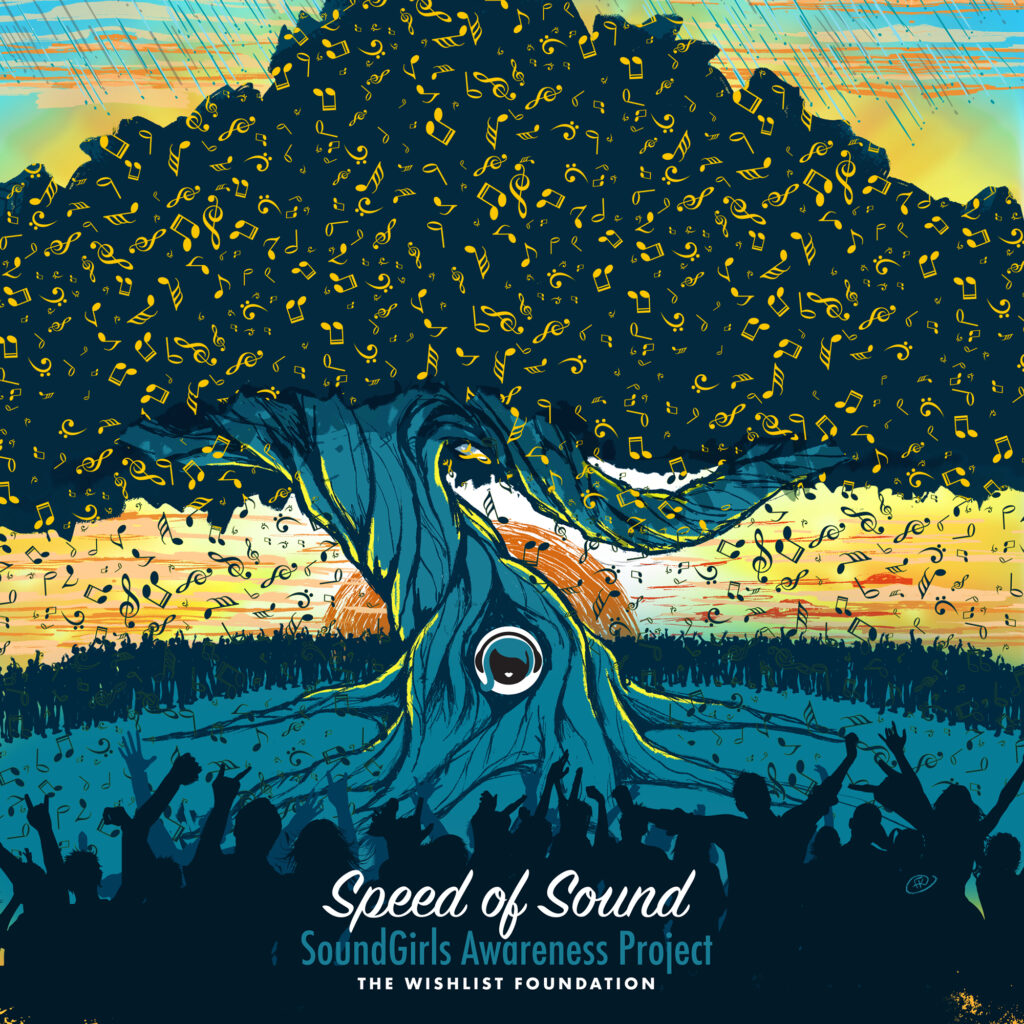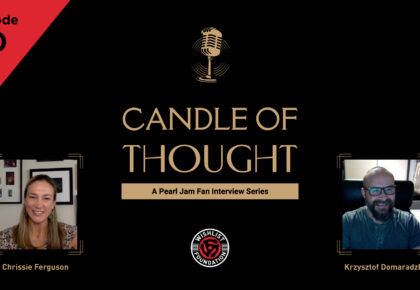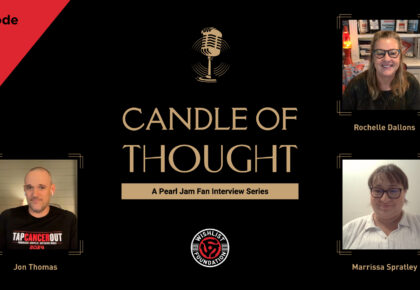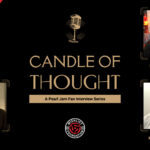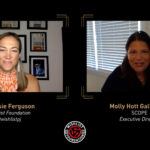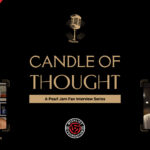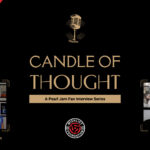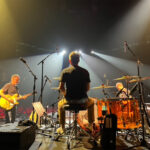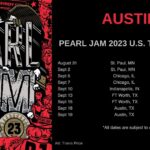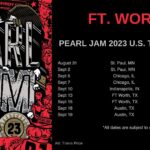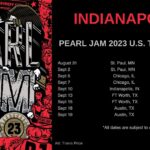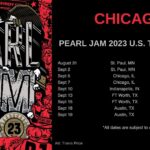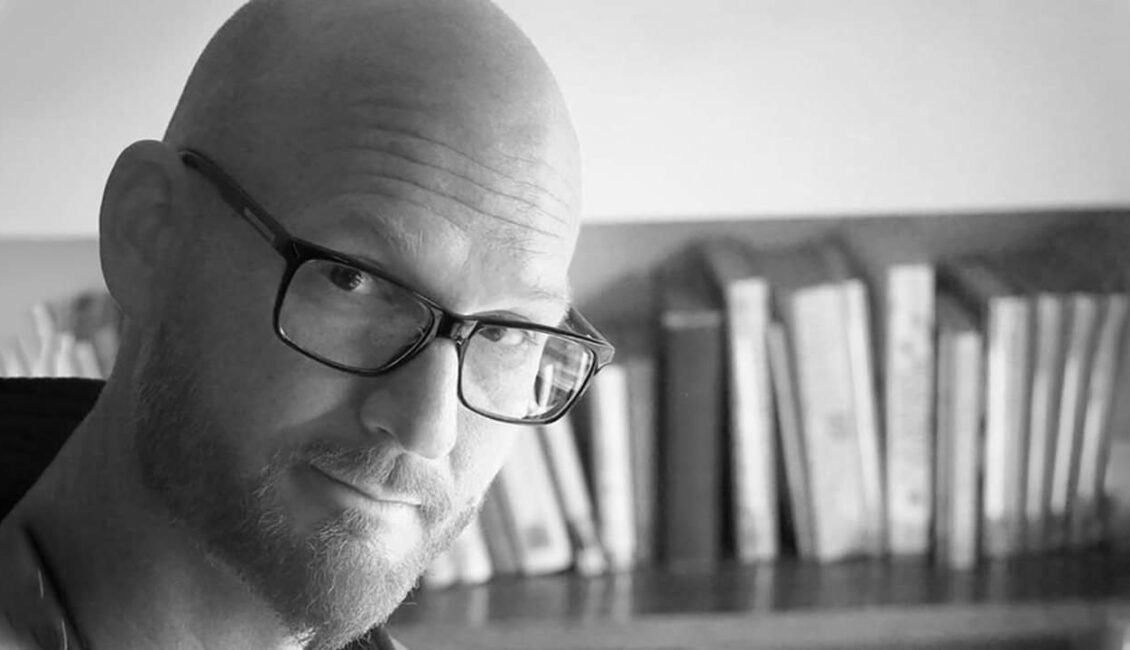
By Chrissie Ferguson
Like a time machine, music instantly transports us to another time and place. This is especially true for us Pearl Jam fans who have spent more than half of our lives listening to the band’s music.
Whether it is a happy moment — like a first love, a wedding day, the birth of a child, or the most mesmerizing PJ concert of our lives. Or maybe it is a sadder moment in time — like love lost or the incredibly horrible pain we felt when we had to say goodbye to someone far too precious to lose.
Whatever the memory – good or bad – for the few minutes that the radio or record player hums the tune we know too well, we instantly travel to another space in time. Magically – just like that – we can paint a moment with our senses. We can smell it. We can hear it. And we can feel it.
But what if you were blessed enough to recreate those moments through the stroke of a pencil or a paintbrush? What if you could capture the lyrics of a song or the lyrics of your life through a single image?
Fred Koehler is one of those blessed few. Koehler, who is most well-known as a writer and illustrator of children’s books, also works as a creative director and a graphic designer.
At the Wishlist Foundation, however, Koehler is known as the artist who perfectly captured the story of live music. In just one image, Koehler’s art helped the Wishlist Foundation and SoundGirls to bring awareness to the current needs of sound techs and engineers through the “SoundGirls Awareness Project.”
I sat down with Fred to learn more about his artistic career and how it feels to utilize his talent to help those in great need in the live music industry.
CHRISSIE: When did your interest in art begin?
FRED: I grew up in love with animation. Everything from Disney to Ninja Turtles to Sonic the Hedgehog. I saw something that I didn’t know how to do, but it fascinated me. I think my life has always been this movement toward, “How can I be as good or as cool or as fun as the people who create these amazing things?” And art has become a lifelong journey.
CHRISSIE: When did you take your steps toward becoming an artist?
FRED: I know I found it in high school. I fit in in my art classes so much more so than in history or math or science. So it was a good way to fill up the elective classes. Everything got filled up with drawing, painting, ceramics, woodblock carving – anything that I could do to stay out of regular class. When it was time to go to college, I didn’t really know what I wanted to do. I knew I wanted to pursue art, but I didn’t know what paths were there because I came from a small town called Sebring, and there weren’t working artists there. So in my mind what it meant to be an artist was to move to New York City and eat Ramen noodles every night, and warm your hands over your last candle, and wait for the sunrise to bring a little warmth. When I found a graphic design program not too far from home, I signed up for it as quickly as I could, and one thing led to another, and I started to get exposed to other forms of art beyond what I had known in my little town.
CHRISSIE: How do you come up with the way that you will illustrate an idea or a story? Do you have to think about it for a while or produce several drafts before you feel confident about an idea?
FRED: As a person who studied advertising and worked in advertising and marketing (for twenty years), the concept always came to me first. I can always tell if I like the idea or not just based on the description or the picture in my head. So a lot of times an entire book project would stem from a single image that made it into my sketchbook. If I could figure out how to stretch that one image into a full story, then I knew I had something.
CHRISSIE: Do some of your best ideas come to you at random times?
FRED: The best ideas come from real life. I’ve had picture book ideas stemming from kids sneaking into my office and spilling a glass of water on my desk. There was a time when we were walking around a lake and a young man was fighting an alligator on the end of a fishing pole. My own kids help me figure out stories while we are driving in the car or going on a hike. In my mind, I call it “picking up shiny objects.” You have this glimmer or spark of something, and you don’t know if it’s a piece of coil or a gold nugget. You really have to pick it up and examine it from all angles. And in that process, you discover if you have something that is worth keeping.
CHRISSIE: Do experiences help you to draw more detailed work? For example, I know that you went backpacking through Scotland and England to find the perfect images for the book, Flashlight Night.
FRED: I believe that it’s easier to describe cold when you’ve been extremely cold. I believe it’s easier to describe loss when you’ve experienced loss. When I want to tell stories about adventure and magic and things of that nature, I want to live those things. So by intentionally putting myself in those situations, I live the adventures that my characters do in my story. Whether or not that makes the art any better, I don’t know. But it makes my life better.
CHRISSIE: How much work goes into a final illustration? How many renderings or sketches?
FRED: You actually got to see it as an art director for the image for SoundGirls. We went through a couple rounds of sketches before we moved to final art. Honestly, I have had some projects where the very first sketch is pretty close to what ended up in the final illustration. And there are other times, like with Flashlight Night where I would send in my sketches, and I would get a 13 page letter of all of the changes they wanted me to make on the first round. The 2nd round was an 11 page letter. And the 3rd round was a 10 page letter. So it can go either way.
CHRISSIE: Is that disheartening, or do you get used to it?
FRED: You never get used to it. Every time an art director or an editor missed what you were going for or didn’t see the brilliance in an idea, it’s like getting stabbed in the heart. To go through 13 pages of that…you can’t even read it in one sitting. You have to process it a little bit at a time. Usually, those editors and art directors are correct. So you have to choose which times you are going to stand up for your concept, and which times do you really need to lean into their vision of what the project can be. Because at the end of the day, when you’re making a book or an album or anything really – unless it’s a standalone show – it’s got to be a collaborative project. So to be successful as an artist, you have to be able to learn how to collaborate with others and take criticism and reflect on it and adjust and grow from it.
CHRISSIE: What projects are you currently working on?
FRED: The next two things are both novels. Garbage Island was my debut novel that came out two years ago about a mouse and a shrew who are stranded on a patch of garbage in the middle of the Pacific Ocean. The sequel is slated for 2021…maybe 2022. I’ve got a lot of revising to do on that book. The one after that is called Treasure Spies. It’s about a group of nerdy friends who are trying to find a lost diamond ring on the beaches of Florida.
CHRISSIE: You created a beautiful illustration for the SoundGirls Awareness Project. How does it feel to know that your art is helping those in need in the live music industry?
FRED: It’s humbling to be asked to participate in a project like this, and it’s so rewarding to see it out there and to know that it’s helping other creatives in need. We all have a heart for one another, and we all look out for each other in this world. And it’s fun to know that something I did is helping to put some dollars in the pockets of those who need it.
CHRISSIE: And now for the most important question…do you listen to Pearl Jam or any music for inspiration while you work?
FRED: (laughs) I get my “Even Flow” on, but only when I am creating art. I listen to Pearl Jam and all sorts of music, especially rock, when I’m doing art. I can’t do it while I’m writing. But I can put on the headphones and jam out while I’m doing my drawing and painting. And that really does make me happy.
CHRISSIE: What would you say to those who might want to follow their dream of becoming an artist, whether it’s an adult or a child?
FRED: The realistic answer that I tell people is “don’t gamble with the rent money.” You’ve got to take care of yourself and your family. You can’t survive on a hope and a dream…and somehow you have to balance that with keeping the fire inside. And as long as that fire stays lit, you will always have a passion for creation, whether you are a writer or a musician, an artist, a sculptor. That passion is key, and it also has to be a joy. It can’t just be drive. You have to become part of your art. Once it becomes so much a part of you, it becomes intertwined with your identity. That’s when it doesn’t matter what you do for your day job because you will always be you in those stolen moments. And those stolen moments when you get to do your art will be so fulfilling.
CHRISSIE: And what would be your response for children?
FRED: For my little people who want to be artists and writers and musicians, I would say, “dive in headfirst.” Take every class you can, hang out with every artist and musician that your folks will let you hang out with. Go to every concert. Be it all. Do it all. Explore and enjoy. We have that time in our lives to find out who we are, and if you have even the slightest inkling who you might be is an artist, it’s worth it to explore that and to find out.
CHRISSIE: Finally, what has been your most exciting or proud moment in your career thus far?
FRED: There have been some nice awards and award ceremonies that I have enjoyed very much. But there is also a kid in my after school program in my neighborhood who I work with one-on-one to get his portfolio in shape so that he can get into art school. I think that being able to pass on what I have learned does make a bigger impact than me selling a million copies of something or having shiny stickers on my book.
Check out Fred’s incredible “SoundGirls Awareness Project” image for purchase on the Wishlist Foundation’s Zazzle account. Purchase the artwork as a poster, a mug, a tote, or as stickers. A portion of your purchase will go directly toward helping techs and engineers in great need during this very difficult time. Thank you, in advance, for your support!
